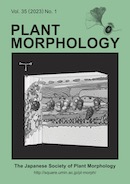Volume 35, Issue 1
Displaying 1-14 of 14 articles from this issue
- |<
- <
- 1
- >
- >|
Cover
-
2023Volume 35Issue 1 Pages 0
Published: 2023
Released on J-STAGE: March 31, 2024
Download PDF (973K)
Invited Review (Special Feature I)
-
Article type: review-article
2023Volume 35Issue 1 Pages 1-2
Published: 2023
Released on J-STAGE: March 31, 2024
Download PDF (2674K) -
Article type: review-article
2023Volume 35Issue 1 Pages 3-8
Published: 2023
Released on J-STAGE: March 31, 2024
Download PDF (2166K) -
Article type: review-article
2023Volume 35Issue 1 Pages 9-15
Published: 2023
Released on J-STAGE: March 31, 2024
Download PDF (1479K) -
Article type: review-article
2023Volume 35Issue 1 Pages 17-22
Published: 2023
Released on J-STAGE: March 31, 2024
Download PDF (4081K) -
Article type: review-article
2023Volume 35Issue 1 Pages 23-28
Published: 2023
Released on J-STAGE: March 31, 2024
Download PDF (1926K) -
Article type: review-article
2023Volume 35Issue 1 Pages 29-33
Published: 2023
Released on J-STAGE: March 31, 2024
Download PDF (1478K) -
Article type: review-article
2023Volume 35Issue 1 Pages 35-39
Published: 2023
Released on J-STAGE: March 31, 2024
Download PDF (1085K)
Invited Review (Special Feature II)
-
Article type: review-article
2023Volume 35Issue 1 Pages 41-48
Published: 2023
Released on J-STAGE: March 31, 2024
Download PDF (1175K)
Minireview
-
Article type: review-article
2023Volume 35Issue 1 Pages 43-48
Published: 2023
Released on J-STAGE: March 31, 2024
Download PDF (4935K) -
Article type: review-article
2023Volume 35Issue 1 Pages 49-57
Published: 2023
Released on J-STAGE: March 31, 2024
Download PDF (2398K) -
Article type: review-article
2023Volume 35Issue 1 Pages 59-67
Published: 2023
Released on J-STAGE: March 31, 2024
Download PDF (7613K) -
Article type: review-article
2023Volume 35Issue 1 Pages 69-75
Published: 2023
Released on J-STAGE: March 31, 2024
Download PDF (3044K)
Poster Abstract
-
Article type: abstract
2023Volume 35Issue 1 Pages 80-89
Published: 2023
Released on J-STAGE: March 31, 2024
Download PDF (851K)
- |<
- <
- 1
- >
- >|
